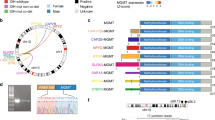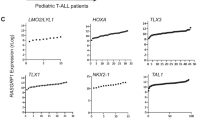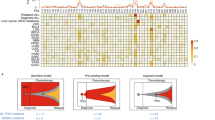Abstract
Tumor cells can acquire aggressive phenotypes secondary to the loss of expression of the wild-type p53 (WTp53) protein or by the gain of function for selected mutant p53 (MTp53) proteins. However, it is unclear as to whether the development of aggressive phenotypes is inter-related. Herein we report the radiosensitivity, chemosensitivity, and in vivo growth characteristics of isogenic p53−/− MEF ras-transformants that variably express an MTp53 protein. Initial experiments revealed significant clonal heterogeneity with respect to cellular sensitivity to DNA-damaging agents (i.e. ionizing radiation, ultraviolet radiation, cis-platinum, and methotrexate) within subclones of a pre-existing p53−/− MEF cell population. Moreover, this differential sensitivity was also observed within subclones of p53−/− MEF cells transformed with an activated ras allele, suggesting that secondary genetic events and clonal selection, but not cellular transformation per se, may drive the resistance patterns for certain null-p53 tumors. In contrast, uniform resistance was observed following the additional transfection of an MTp53 allele (MTp53pro193) into p53−/− MEF transformants and p53−/− DP-16 Friend erythroleukemia cells, consistent with a gain of MTp53 function for this allele. Relative tumor growth rate and experimental metastatic ability was not enhanced by MTp53pro193 expression. Our results support the concept that gain of MTp53pro193 function leads to the selection of dominant clones, which may exhibit cellular resistance following cancer therapy.
This is a preview of subscription content, access via your institution
Access options
Subscribe to this journal
Receive 50 print issues and online access
$259.00 per year
only $5.18 per issue
Buy this article
- Purchase on Springer Link
- Instant access to full article PDF
Prices may be subject to local taxes which are calculated during checkout



Similar content being viewed by others
References
Albor A, Kaku S and Kulesz-Martin M . (1998). Cancer Res., 58, 2091–2094.
Bernstein C, Bernstein H, Payne CM and Garewal H . (2002). Mutat. Res., 511, 145–178.
Blandino G, Levine AJ and Oren M . (1999). Oncogene, 18, 477–485.
Bristow RG, Benchimol S and Hill RP . (1996). Radiother. Oncol., 40, 197–223.
Bristow RG, Hu Q, Jang A, Chung S, Peacock J, Benchimol S and Hill R . (1998). Oncogene, 16, 1789–1802.
Bullock AN, Henckel J and Fersht AR . (2000). Oncogene, 19, 1245–1256.
Cadwell C and Zambetti GP . (2001). Gene, 277, 15–30.
Chang BD, Xuan Y, Broude EV, Zhu H, Schott B, Fang J and Roninson IB . (1999). Oncogene, 18, 4808–4818.
Dittmer D, Pati S, Zambetti G, Chu S, Teresky AK, Moore M, Finlay C and Levine AJ . (1993). Nat. Genet., 4, 42–46.
Donehower LA, Harvey M, Slagle BL, McArthur MJ, Montgomery Jr CA, Butel JS and Bradley A . (1992). Nature, 356, 215–221.
Foster BA, Coffey HA, Morin MJ and Rastinejad F . (1999). Science, 286, 2507–2510.
Gaiddon C, Lokshin M, Ahn J, Zhang T and Prives C . (2001). Mol. Cell. Biol., 21, 1874–1887.
Gangopadhyay S, Jalali F, Reda D, Peacock J, Bristow RG and Benchimol S . (2002). Exp. Cell Res., 275, 122–131.
Grant SW, Kyshtoobayeva AS, Kurosaki T, Jakowatz J and Fruehauf JP . (1998). Cancer Detect. Prev., 22, 185–194.
Gualberto A, Aldape K, Kozakiewicz K and Tlsty TD . (1998). Proc. Natl. Acad. Sci. USA, 95, 5166–5171.
Harvey M, Sands AT, Weiss RS, Hegi ME, Wiseman RW, Pantazis P, Giovanella BC, Tainsky MA, Bradley A and Donehower LA . (1993). Oncogene, 8, 2457–2467.
Hoeijmakers JH . (2001). Nature, 411, 366–374.
Hsiao M, Low J, Dorn E, Ku D, Pattengale P, Yeargin J and Haas M . (1994). Am. J. Pathol., 145, 702–714.
Illidge TM, Cragg MS, Fringes B, Olive P and Erenpreisa JA . (2000). Cell. Biol. Int., 24, 621–633.
Iwamoto KS, Mizuno T, Ito T, Tsuyama N, Kyoizumi S and Seyama T . (1996). Cancer Res., 56, 3862–3865.
Iwanaga Y and Jeang KT . (2002). Cancer Res., 62, 2618–2624.
Kieser A, Weich HA, Brandner G, Marme D and Kolch W . (1994). Oncogene, 9, 963–969.
Kirsch DG and Kastan MB . (1998). J. Clin. Oncol., 16, 3158–3168.
Li R, Sutphin PD, Schwartz D, Matas D, Almog N, Wolkowicz R, Goldfinger N, Pei H, Prokocimer M and Rotter V . (1998). Oncogene, 16, 3269–3277.
Lin Y and Benchimol S . (1995). Mol. Cell. Biol., 15, 6045–6054.
Liu MC and Gelmann EP . (2002). Semin. Oncol., 29, 246–257.
Liu G, McDonnell TJ, Montes de Oca Luna R, Kapoor M, Mims B, El-Naggar AK and Lozano G . (2000). Proc. Natl. Acad. Sci. USA, 97, 4174–4179.
Melchior F and Hengst L . (2002). Cell Cycle, 1, 245–249.
Monti P, Campomenosi P, Ciribilli Y, lannone R, Inga A, Abbondandolo A, Resnick MA and Fronza G . (2002). Oncogene, 21, 1641–1648.
Morris SM . (2002). Mutat. Res., 511, 45–62.
Offer H, Milyavsky M, Erez N, Matas D, Zurer I, Harris CC and Rotter, V . (2001). Oncogene, 20, 581–589.
Peacock JW, Chung S, Bristow RG, Hill RP and Benchimol S . (1995). Mol. Cell. Biol., 15, 1446–1454.
Powell SN, DeFrank JS, Connell P, Eogan M, Preffer F, Dombkowski D, Tang W and Friend S . (1995). Cancer Res., 55, 1643–1648.
Pugacheva EN, Ivanov AV, Kravchenko JE, Kopnin BP, Levine AJ and Chumakov PM . (2002). Oncogene, 21, 4595–4600.
Roth JA, Grammer SF, Swisher SG, Komaki R, Nemunaitis J, Merritt J and Meyn RE . (2001). Acta Oncol., 40, 739–744.
Selivanova G . (2001). Curr. Opin. Invest. Drugs, 2, 1136–1141.
Sharpless NE and DePinho RA . (2002). Cell, 110, 9–12.
Sigal A and Rotter V . (2000). Cancer Res., 60, 6788–6793.
Slichenmyer WJ, Nelson WG, Slebos RJ and Kastan MB . (1993). Cancer Res., 53, 4164–4168.
Slingerland JM, Jenkins JR and Benchimol S . (1993). EMBO J. 12, 1029–1037.
Smith ML and Seo YR . (2002). Mutagenesis, 17, 149–156.
Soussi T and Beroud C . (2001). Nat. Rev. Cancer, 1, 233–240.
Strano S, Fontemaggi G, Costanzo A, Rizzo MG, Monti O, Baccarini A, Del Sal G, Levrero M, Sacchi A, Oren M and Blandino G . (2002). J. Biol. Chem., 13, 13.
Takimoto R, Wang W, Dicker DT, Rastinejad F, Lyssikatos J and el-Deiry WS . (2002). Cancer Biol. Ther., 1, 47–55.
Tang W, Willers H and Powell SN . (1999). Cancer Res., 59, 2562–2565.
Tannock IF and Lee C . (2001). Br. J. Cancer, 84, 100–105.
van Oijen MG and Slootweg PJ . (2000). Clin. Cancer Res., 6, 2138–2145.
Wahl GM and Carr AM . (2001). Nat. Cell. Biol., 3, E277–E286.
Wiesmuller L . (2001). J. Biomed. Biotechnol., 1, 7–10.
Author information
Authors and Affiliations
Corresponding author
Rights and permissions
About this article
Cite this article
Bristow, R., Peacock, J., Jang, A. et al. Resistance to DNA-damaging agents is discordant from experimental metastatic capacity in MEF ras-transformants-expressing gain of function MTp53. Oncogene 22, 2960–2966 (2003). https://doi.org/10.1038/sj.onc.1206405
Received:
Revised:
Accepted:
Published:
Issue Date:
DOI: https://doi.org/10.1038/sj.onc.1206405
Keywords
This article is cited by
-
Therapeutic targeting of p53: all mutants are equal, but some mutants are more equal than others
Nature Reviews Clinical Oncology (2018)
-
Tumor senescence and radioresistant tumor-initiating cells (TICs): let sleeping dogs lie!
Breast Cancer Research (2010)
-
Impaired p53 binding to importin: a novel mechanism of cytoplasmic sequestration identified in oxaliplatin-resistant cells
Oncogene (2009)



